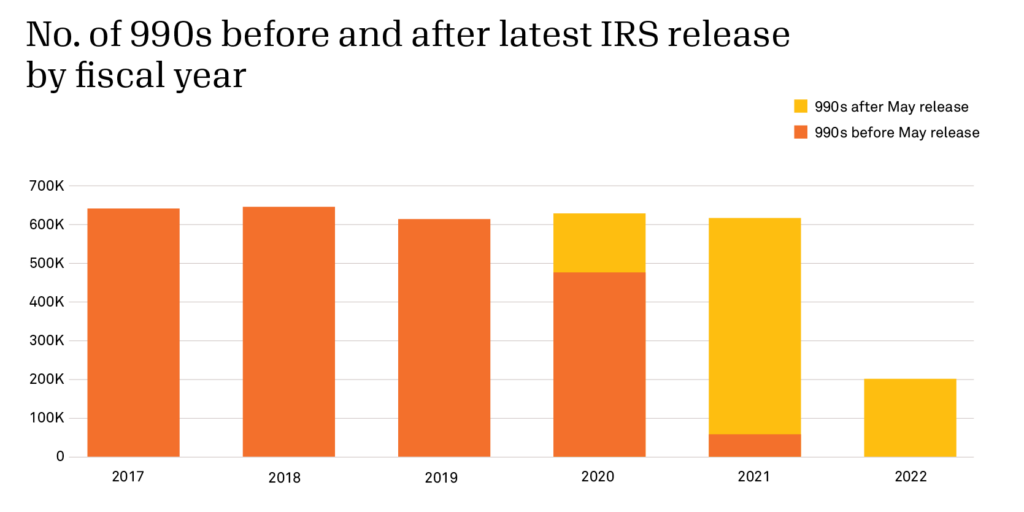In mid-May 2023, shouts of joy could be heard in the Candid offices. Passersby might have assumed a favorite sports team just won a game. Or maybe there was a landing on Mars. But no, we were just celebrating the release of new 990s.
For those unfamiliar with the world of 990s: U.S. tax-exempt organizations are requested to file Forms 990 with the IRS annually, sharing information about their organization’s size, location, revenue, grantmaking, etc. In a sector where transparency is not always a given, 990s offer a window into what is happening across and within organizations. Candid uses 990 data as a starting place for our nonprofit profiles and grantmaking databases. So, a few weeks ago when the IRS released around one million 990s…it felt like Christmas.
Pandemic-related 990 delays have hampered the field
This data has been long awaited. Before the COVID-19 pandemic, Candid received comprehensive IRS 990 data about 1.5–2 years after the end of a given calendar year. But IRS extensions, process changes, and delays during the pandemic slowed this timeline to a frustrating crawl. We’ve dubbed this the data/crisis catch-22—the fact that the pandemic made up-to-date data more critical to access and yet also more difficult to come by.
In fact, between August 2022 and April 2023, the IRS released very little 990 data at all. Because of this, we have been considering 990 data for fiscal years 2020 onward “incomplete”i; research leveraging 990 data for years 2020 and on required the caveat that data collection was ongoing. Eager for information, many researchers turned to surveys, leading to sector-wide survey fatigue and survey response rates as low as 1%.
Details and impact of the May 2023 990 release
Between May 5–18, 2023, the IRS released around a million 990 files. To put these numbers into perspective, in April 2023, Candid could only account for about 60k 990 filings for fiscal years 2021 and 2022 combined. Today we have over 800k filings for those years. Moreover, our latest numbers suggest that not only do we now finally have comprehensive 990 data for 2020…we have it for 2021 as well!

What happens now?
As you might imagine, the 990 drop has meant busy times at Candid. The whole sector has been waiting on this data, and we’re determined not to add to the delays. We’re happy to share that we’ve been able to integrate the vast amount of new 990 data into most of our various tools and databasesii in record time. This includes adding our signature Candid enhancements to the raw datasets (e.g., adding Philanthropy Classification System codes, geolocation enhancements, precalculated financial metrics, and matching and deduplicating records).
Moreover, finally having 990s from 2020–2021 means that we gain a more comprehensive picture of what happened to our sector during the COVID-19 pandemic. The data offers empirical answers to so many questions that have been swirling around the field (e.g., how many nonprofits closed their doors in 2020? Did grantmakers change their grantmaking practices in 2020? How much money went to racial equity in 2020?). The Candid Insights team is already looking into incorporating the new data into upcoming blogs and research reports. We know our fellow researchers around the sector are eagerly doing the same.
What’s in the future for 990s and Candid data?
We don’t have a crystal ball to predict the future of 990s, but this release leaves us cautiously optimistic. A few months ago, we were resigned to a three-year (or more) lag on IRS data. Now, bouncing back to a 1.5–2-year timeline feels at least possible. Either way, at Candid, we’re not holding our breath. We are always pursuing new ways to gather and share timely information about the sector, from using data science to collect publicly available 990s to sharing demographic data.
We urge foundations to share data with us directly as a data sharing partner so that the sector doesn’t have to wait 1.5–3 years for grantmaking information. We also urge nonprofits to claim their nonprofit profile, where they can upload their 990s directly and tell the world about their work.
The past few years have been characterized by unprecedented change and disruption. Now more than ever, the social sector needs comprehensive and up-to-date data to support informed decision-making about our future.
i The number of 990s year over year is relatively stable, so we knew a lot of data was missing.
ii In an effort to get this data out as fast as possible, we prioritized our flagship tools (GuideStar and Foundation Directory), both of which now have up-to-date 990s. Processing is ongoing for smaller and/or more manual datasets (e.g., the Foundation 1000 research set).
